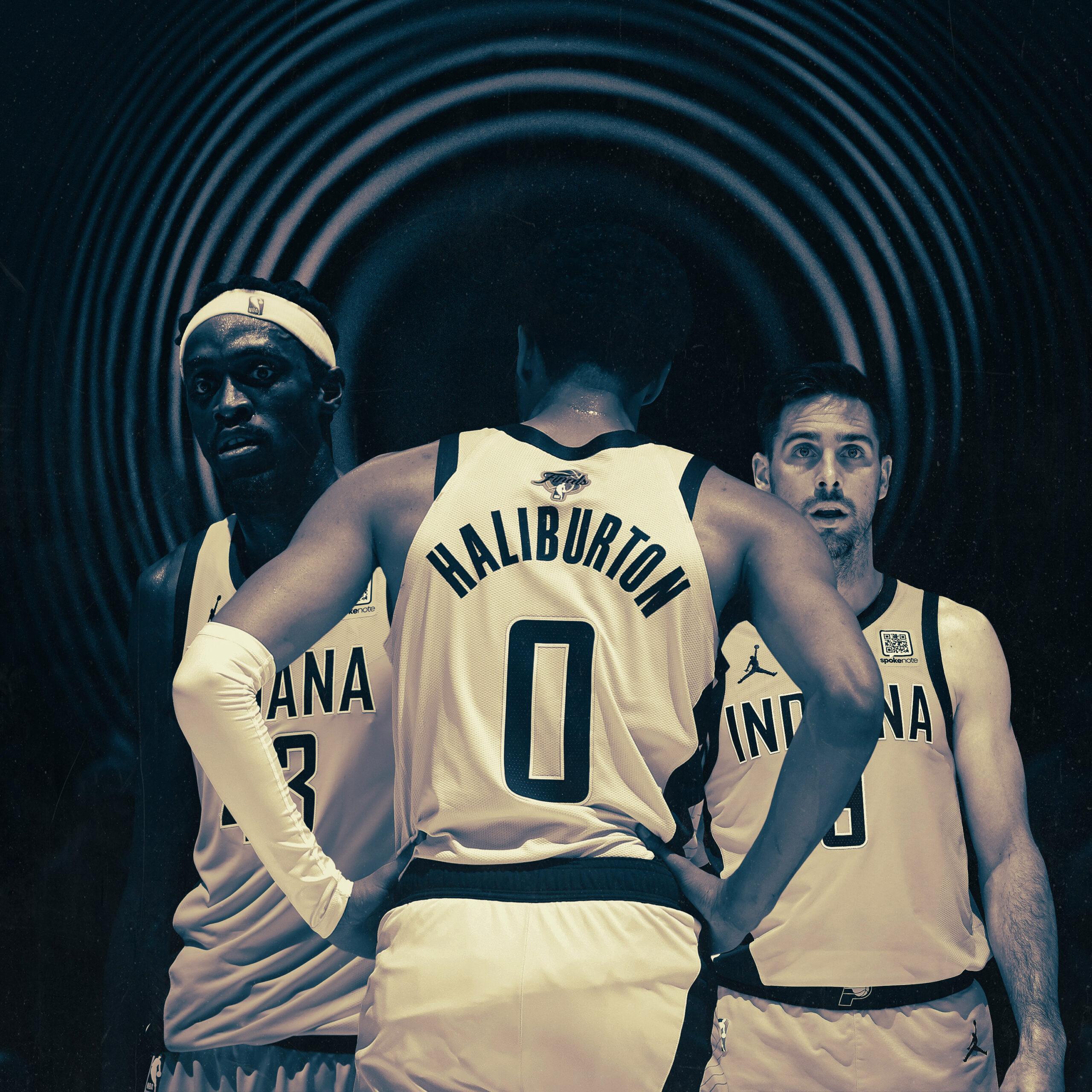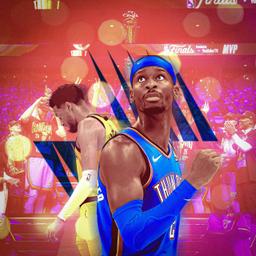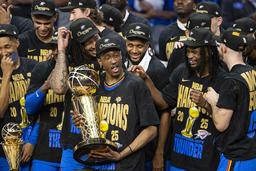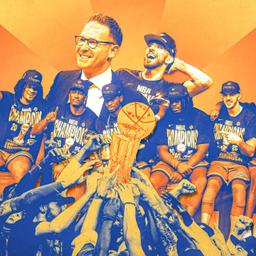
The first five minutes of the biggest game Tyrese Haliburton will ever play were a continuation of the most magical playoff run a franchise and its star could possibly share. Haliburton ripped off nine points by hitting three of his first four 3s, jumping on the Oklahoma City Thunder with the same dauntless concentration that led his Indiana Pacers to Game 7 of the NBA Finals.
Then it all went to hell. With 4:55 on the clock, Andrew Nembhard drove left and kicked out to Obi Toppin in the strongside corner. Thunder guard Lu Dort scrambled out to the ball and forced a swing up to Haliburton on the wing. He caught the pass, planted his right leg for a drive, and crumpled to the ground. Playing through a calf strain that reportedly would have sidelined him for weeks had it been during the regular season, the severity of Haliburton’s fall was apparent almost immediately. He winced, slapped the court, and didn’t get up.
A couple of hours later, after the Pacers’ last gasp of a comeback fizzled out and a heartbreaking loss that will reverberate into and possibly beyond 2026 became their new reality, a slight window opened to process Haliburton’s Achilles injury as a “what if” event for the ages. What could have been for this relentless Indiana team if it’d had its best player at full strength? Without Haliburton, the Pacers submitted their highest turnover rate of the season in Game 7—such a cruel way for this serendipitous, inevitable, and so damn captivating journey to end.
“He authored one of the great individual playoff runs in the history of the NBA with dramatic play after dramatic play,” Pacers head coach Rick Carlisle said after Game 7. “It was just something that no one’s ever seen and did it as one of 17. You know, that’s the beautiful thing about him. As great a player as he is, it’s always a team thing.”
In the aftermath of watching any group lose in Game 7 of the NBA Finals, appreciation is a distant emotion. But without taking anything away from the Thunder, a dominant champion that took care of business all season long, if any runner-up in history deserves to be remembered more fondly than the team that just beat it, it’s the Pacers. How did this endearingly scrappy team come within 24 minutes of an NBA title, and, going forward, which elements from their script will be studied, and then imitated successfully, by other organizations around the league?
Technically speaking, every NBA team has a legacy. On average, every season, it can fit on a Post-it note—shrugged off, barely remembered, entirely forgotten by even the most diehard fans. But a special few—overachievers, innovators, and champions—are appreciated and debated, for one reason or another, long after they’re gone. These outliers come to symbolize so much more than what they did or didn’t accomplish. Some are celebrated for a singular Cinderella run. Some live on as a widely influential blueprint for others to build upon. Others enjoy inimitable success and inspire nothing but one hopeless parody after another; there’s no stealing the recipe from a team that employs Larry Bird, Michael Jordan, Tim Duncan, LeBron James, Steph Curry, or Nikola Jokic.
This brings us to the Pacers, one of the more hopeful, thrilling, and unbelievable success stories in NBA history, a team that was +6600 to win it all before this season began and +10000 at the All-Star break, and had the highest title odds on record for a conference champion.
It’ll take months for us to fully process everything they did in the playoffs—how they effectively broke win-projection models in real time by making a slew of winning plays along their legendary run. How they physically and mentally wore their opponent down and never stopped coming. It was relentlessness of the highest order.
In every round, the Pacers completed the type of comeback many fan bases spend their entire existences dreaming about. First it was Game 5 against Milwaukee, when Indiana trailed by seven with 40 seconds left in overtime and won on a go-ahead layup by Tyrese Haliburton 39 seconds later. They quickly executed another magic trick in Game 2 of the following round against the Cavaliers, coming back from another seven-point deficit with 47 seconds to go.
Then Indiana kicked off the Eastern Conference finals with the most implausible series of events I’ve ever seen on a court with my own two eyes: a 138-135 overtime victory over the New York Knicks despite trailing by 14 with 3:16 left in the fourth quarter. Haliburton’s foot-on-the-line stepback 2 as time expired lay somewhere between a moment of destiny and an audacious prank. I’m still wondering, weeks later, how that ball managed to ricochet several feet off the rim, straight up into the air, and through the basket. It was witchcraft.
Haliburton’s theatrical choke sign was the pièce de résistance. The phenomenon spilled into Game 1 of the Finals, when he quieted one of the loudest crowds I’ve ever heard with a 21-foot pull-up with 0.3 seconds left to play. The Pacers had trailed by double digits for most of the evening.
It was surreal and inevitable at the same time; a dichotomy that may always be hard to parse. Here we had the most resilient team in recent memory, but no consistently irrepressible bucket getter at the top of their food chain.
Appear weak when you are strong and strong when you are weak is a rule from Sun Tzu’s The Art of War. Both sides of that coin describe the Pacers to a T. Consider this: In the last minute of games that had a scoring margin within five points, Indiana finished the postseason plus-17. The sample size we’re talking about is nine minutes. Incredible stuff. The Pacers’ net rating in crunch time was plus-31.5. Their eyes dilate but never blink.
Zoom out and the season was a fairy tale. The Pacers nearly won the title despite finishing below the luxury tax and having only one player on their roster who averaged 20 points per game (Pascal Siakam’s 20.2 scoring average just made the cut). Somehow, 22-year-old Bennedict Mathurin was their third-leading scorer during the regular season, and two centers in their opening-night rotation tore their Achilles tendons in the first week of the season. On December 8, the Pacers were beaten by a Charlotte Hornets team that allocated about 50 minutes to DaQuan Jeffries, Isaiah Wong, and KJ Simpson. The loss dropped them to 10-15, 10th place in a woeful Eastern Conference.
They went 40-17 from there, with a top-seven offense and defense. Only the Thunder, Cavaliers, and Celtics had a better winning percentage over that span. Healthier personnel helps explain the turnaround, but it’s also a macrocosm of the postseason miracles that were to come. The Pacers just keep playing like the Pacers, which is to say they deploy a scheme that puts their opponent in a singular kind of basketball hell: full-court pressure, constant ball movement, never-ending dribble handoffs, shooting at every position, an obsession with pace and ball protection, disciplined transition defense, and a wise, tactical contrarian for a head coach who instills confidence in a deep roster that epitomizes the age-old axiom of their whole being greater than the sum of its parts.
After their first Finals appearance in 25 years, going all the way to a semi-competitive Game 7 that was deflated, to a certain extent, by Haliburton’s injury, it’s too soon to definitively say what the legacy of these Pacers will be—whether they’re an admirable aberration or a trend-setting force of nature. But in that void, there’s a very real chance—with some help from the straitjacket this CBA has locked every big spender in—that they’ll help change the league, aesthetically and compositionally.
“We are put together really, probably, unlike any other team in the NBA in terms of our dependence on one another,” Carlisle said during the Finals. “You can look at the stats, and individual guys having big nights is a big part of success. But with us, the thing that works for us is balance. A lot of guys involved, a lot of guys passing it. A spirit that is evident, positive, regardless of whether things are going good or bad.”
Throughout league history, franchise players on the most successful teams have understood and accepted that idea while still being able to thrive as independent, score-first control freaks in the biggest moments. It’s here where, before he went down, Haliburton bucked convention in ways that were brilliant and, to many, frustrating. When the playoffs started, he was considered a top-10 player by approximately zero people. Haliburton wasn’t good enough to make this season’s All-Star team and has yet to ever crack first- or second-team All-NBA.
It’s impossible to know how Haliburton’s injury will affect the rest of his career, but the run he had should forever transform how he’s perceived. Moving forward, no one who believes he’s overrated can be taken seriously. On the contrary, true visionaries who inhabit unteachable selflessness do not grow on trees. Haliburton will have coaching staffs around the league begging their primary scorers to sacrifice a little bit more. The sales pitch writes itself: Pass, cut, move, screen, and push more often and defenses will have a much harder time slowing you down.
“They play with a lot of spontaneity,” Thunder head coach Mark Daigneault said. “They don’t overcontrol the game, their coaching or their players. So it requires a conceptual approach defensively. If you go out there and you’re like, ‘Hey, we’re trying to stop this one player,’ they’re going to get you somewhere else. You kind of have to approach the game the way they do on that end of the floor, which is unique.”
This all speaks to a larger philosophical showdown that’s years in the making. Heliocentrism vs. equal-opportunity offense. The latter is impossible without acceptance. Indiana isn’t the first team to make the Finals with a high assist rate. There’s precedent here, stylistically, though previous teams to do it always included several first-ballot Hall of Famers.
For their lack of a skeleton key who demands double-teams and sews untenable anxiety off the ball, the Pacers have embraced a formula on both sides of the ball that, for one big reason, is rarely seen in the NBA: It’s extremely unpleasant. In addition to picking up the ball 90 feet from the rim, Indiana’s defense switches fewer picks than any other team in the league, per Sportradar. They also have the screener’s defender show more frequently than any other team, and whoever’s guarding the ball handler on a pick-and-roll goes over the screen 63 percent of the time, which also ranks first.
“It’s a difficult system, and it just requires a lot of sacrifice,” Carlisle said. “But when you execute it the right way, you know, whether it’s two years ago in some game that doesn’t seem very meaningful in mid-January or in Game 3 of the Finals, these guys see where important things are important, and hard things are hard. That’s a phrase I’ve used many times: ‘Hard things are hard.’ But our guys, they have made the investment, and it’s an ongoing thing. It’s like a great marriage; it’s a lot of work.”
Somewhat related to that concept: These Pacers are a monument to the value of continuity, benefiting from the chemistry, trust, and level of accountability that’s forged when a large segment of one year’s roster forges ahead instead of breaking apart.
There are organizations that would’ve watched last year’s postseason end with a sweep in the conference finals and not feel much confidence in their ability to compete for a championship. They would’ve sold high on some integral pieces or aggressively searched for an upgrade at center. Instead, Indiana’s front office stood pat and rolled back a higher percentage of the previous season’s minutes than every team except the champion Boston Celtics.
Patience and self-belief go hand in hand; the Pacers are not short on either trait. Under Carlisle, they learned from their mistakes without abandoning the fundamental identity that finally culminated in this season’s epic run to the summit. Indiana has ranked second, third, or fourth in touches and passes every season since he was hired in 2021—quick decisions are a nonnegotiable part of who they are.
The legacy of this team may simply be the way they’ll supply hope for every team that doesn’t have a verifiable MVP candidate to build around. Talent will always matter, but identifying the perfect style of play and then doubling down on whatever it might be—push through the pain instead of succumbing to it every July—could become more adequate. There are specific elements of this team that are replicable, but it’s hard to play fast and mistake-free without someone like Haliburton as your conductor. The Memphis Grizzlies were (correctly) on a similar track, but it came against their own franchise point guard’s wishes. Everyone has to be on the same page and prepared to embrace outside-the-box thinking even when it doesn’t lead to a win every night. Move without the ball, execute thankless tasks, and channel your ego toward the greater good.
That sounds trite, but in a financial system that makes it so hard to build around multiple max contracts, Indiana’s effort to implement a system that makes everyone feel involved and engaged has baked in an implicit reward structure that thrusts the entire team into a higher tier than its top two or three players indicate it should be. It’s brilliant.
Now, though, in light of a catastrophic injury to their best player, the Pacers face a tough road ahead. Should they dip into the tax, re-sign Myles Turner, and bring Mathurin back if a repeat run to the Finals is next to impossible? (Trading to get their own first-round pick back in 2026 suddenly looks like a stroke of genius.) Despite some tough decisions that lie ahead, the painful way Indy’s season came to an end should not overshadow how unforgettable this run to the finish line really was.
Even if Haliburton isn’t on the court next season, the Pacers’ influence should still be seen in ways that stretch from subtle to overt. There are no moral victories in the NBA Finals, but this was a special team. And right now, even as they suffer through the pangs of regret and what could’ve been, the Pacers should take pride in knowing that, in a copycat league, there’s a good chance no team will motivate more stylistic plagiarism over the next few years than these Indiana Pacers will.





